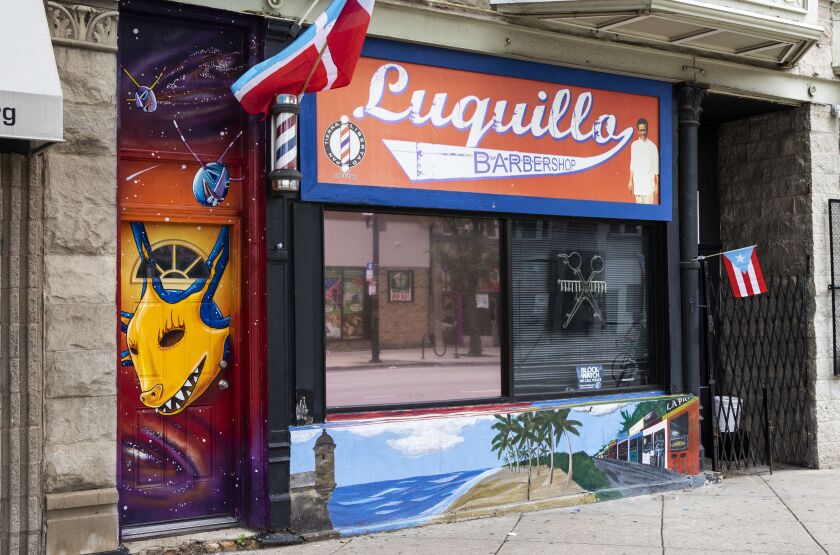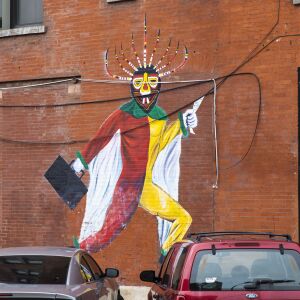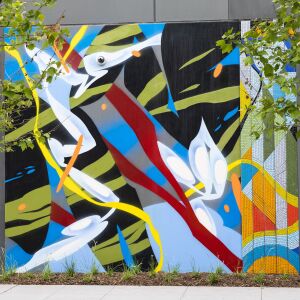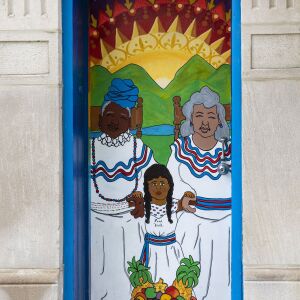Humboldt Park has some of the most controversial public art in Chicago, rooted in political commentary on the Puerto Rican community’s struggles with police violence, displacement and self-determination.
Murals there also portray Puerto Rico’s struggle to gain sovereignty from Spain and later from the United States.
The murals reflect the identity crisis many Puerto Ricans must deal with, according to José López, executive director of the Puerto Rican Cultural Center. López says the main thing many know about their culture is their flag — a white star within a blue triangle, with red and white horizontal stripes. Even the public painting of that flag — a unifying thread among most murals in the neighborhood — often has been a political statement in itself.
“The Puerto Rico flag itself was an illegal symbol for many years, but it was the only thing that Puerto Ricans knew about Puerto Rico,” López says. “Puerto Ricans didn’t know anything about their history because it wasn’t taught anywhere.”
In Puerto Rico until 1952, it was a crime to display a flag or sing any patriotic songs that weren’t in favor of the United States. In many ways, López says, Puerto Ricans outside of the island, which has been a U.S. territory and thus part of the United States since the late 1800s, kept the flag alive.
“I spent my whole life in this identity limbo,” says Cristian Roldán, a Puerto Rican muralist who lives in Humboldt Park. “When I came to this neighborhood, I saw this as a space where I could recreate myself.”
In 2016, Roldán painted “Repression, Resistance and Resilience” at 2524 W. Division St., dividing the large mural into five sections covering the history of the Puerto Rican people, beginning with the indigenous Taínos people and ending with the 1966 Division Street riots, sparked by a police officer shooting and wounding a Puerto Rican teenager.
“Painting that mural, I learned the importance of politicizing the public space and doing it through art,” Roldán says. “It allows us to tell the other side of the story, the one that has been erased.”
As Roldán‘s and others see it, such works are created to “rescue the collective memory” and move people to think more critically about history.
Such thinking was behind what’s believed to be the oldest outdoor mural in Humboldt Park, titled “The Crucifixion of Don Pedro Albizu Campos.”
Considered a terrorist by some, Campos is considered the father of the independence movement, the leader of the Puerto Rican Nationalist Party. The Humboldt Park mural shows Campos as a Christ-like figure on a cross while Luis Munoz Marin, former governor of Puerto Rico, is poised to strike him with a spear. Beside Campos, also on crosses, are fellow Puerto Rican nationalists Lolita Lebrón and Rafael Cancel Miranda.
In 1954, Lebrón and Cancel Miranda led an attack on the U.S. House of Representatives that left five congressmen wounded. Both served 25 years in prison before President Jimmy Carter pardoned them in 1979.
“Our murals are becoming almost like a book or a visual library, and we are doing this by painting the most visible corridors in the neighborhood,” says Luis Raúl Muñoz, another Puerto Rican muralist.
Muñoz’s mural “Our Story of Resilience” depicts people from the Young Lords Party — a Puerto Rican political movement founded in Chicago that mirrored itself on the Black Panther Party — holding a Puerto Rican flag and marching.
Influential in the 1960s and 1970s, the movement fought government efforts at “urban renewal” and pushed to improve housing and socioeconomic conditions for Puerto Ricans.
With growing gentrification in Humboldt Park, Muñoz says the murals are more important than ever.
“Every time someone walks past our murals, it’s almost like cultural advertisement,” Muñoz says. “People are forced to reflect on their identity because a lot of us have amnesia to who we are.”
Click on map below for a selection of Chicago-area murals
Manny Ramos is a corps member of Report for America, a not-for-profit journalism program that aims to bolster Sun-Times coverage of Chicago’s South Side and West Side.















































